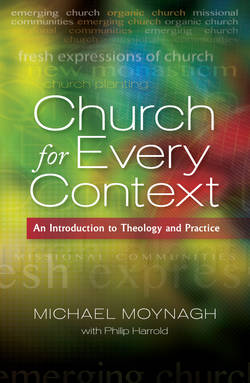Читать книгу Church for Every Context - Michael Moynagh - Страница 67
Combinations of difference
ОглавлениеAgainst this background were spontaneous moves to express church in new ways. Goldstein, Hazy and Silberstang (2010, p. 111) note how novelty occurs through the unexpected combination of different elements. They quote Kary Mullis, Nobel Laureate in chemistry: ‘In a sense, I put together elements that were already there, but that is what inventors always do. You can’t make up new elements, usually. The new element, if any, it was the combination, the way they were used.’
Novel combinations characterized many new expressions of church before the Mission-shaped Church report. Groups experimenting with alternative worship joined elements from popular culture, such as multimedia, to worship in combinations not seen before. In the late 1980s and early 1990s, the Nine O’clock Service (NOS) in Sheffield – a young adults’ congregation that peaked at 600 – put alternative worship firmly on the map. Despite the demise of NOS following allegations of sexual and emotional abuse by its leader, a variety of groups such as Oxford Youth Works and Grace Church in West London continued to bring elements from contemporary culture and the Christian tradition together in innovative forms of worship. In January 2011, www.alternativeworship.org listed 37 groups in the UK that were within the alternative worship ethos.
By 2000 perhaps up to 100 youth and teenage congregations of various kinds had emerged (Moynagh, 2001, p. 110). They included the ‘Soul Survivor’ network of youth churches and Revelation Youth Church in Chichester. Many were combining food, ingredients from contemporary culture, informal interaction and Christian practices in ways that, for the time, were strikingly new. Some were entirely spontaneous and unconnected with groups elsewhere, such as a couple who rented temporarily a vacant vicarage on a council estate, got to know some of the local teenagers (who had never been to church), invited them regularly into their lounge and a year later commented, ‘I suppose we’ve started an emerging church.’ For them lounge, church and unauthorized leadership was an unexpected combination.
Other novel combinations included the founding in 1998 of a separate congregation for people who had been through the Alpha course at Holy Trinity, Margate, uniting the concepts of Alpha and being a congregation for possibly the first time. Under the remit of Urban Expressions, in the late 1990s church plants in London’s East End brought together home, food and worship in a manner that was certainly not new to the Christian tradition, but was not how most people in the capital experienced church.
By the mid 2000s, unusual combinations had multiplied. In Liverpool making bread was locked together with church (Glasson, 2006). At Haydock, Merseyside, missional clusters were introduced alongside the existing cell model of church. They included FamLeigh First, which combined the notion of parish with school: a faith community owned the school as its ‘parish’ (Hopkins and Breen, 2007, p. 24). The first Fresh Expressions DVD, published in 2006, contained examples of church coalescing with a skateboard park, with surfers and with cafe.6 Creative expressions of church had joined-up thinking at their core.
Goldstein, Hazy and Silberstang (2010, p. 113) suggest that a further element is needed to generate novelty – the coming together of different perspectives; two or more people tackling a problem pool their different insights. They cite research highlighting the importance of diversity in the creative process. At a national level Archbishop Rowan Williams, an Anglo-Catholic with a liberal ethical theology, injected an element of diversity into the fresh expressions story. As Bishop of Monmouth, Williams was vexed by the disconnection between the church and the bulk of the population, and had direct experience of some imaginative church plants in the diocese. This set him on a path of reflection that prepared him to make Mission-shaped Church a priority when it was published soon after his translation to Canterbury.
His support broadened the church-planting tradition in the Church of England, which had been dominated by evangelicals (who also comprised most of the Mission-shaped Church working party). It became easier for the whole church to endorse the report. Archbishop Rowan himself contributed the phrase ‘mixed economy’ to describe different types of church existing alongside each other in mutual respect and support (Croft, 2008c, p. 5).
Disequilibrium has involved
mounting dis-ease with existing church;
fresh expressions of church, involving novel combinations, that suggested new ways of practising church.
